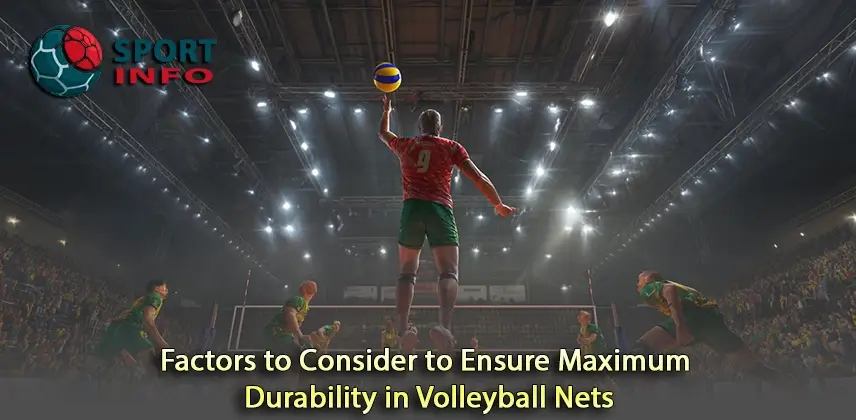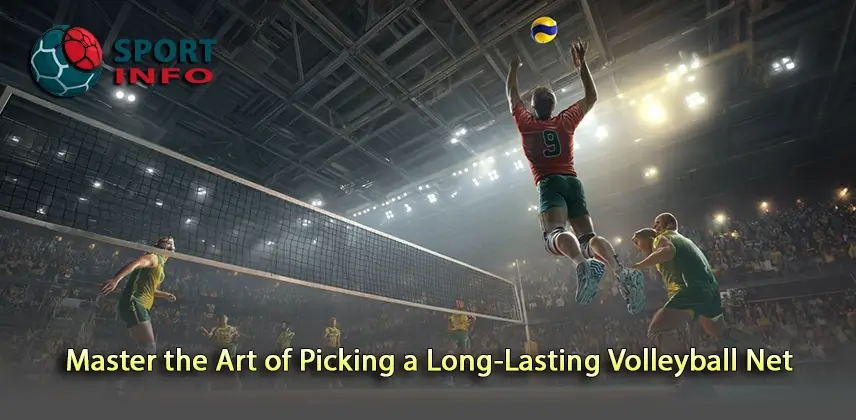Choosing the right volleyball net can make all the difference in your playing experience. But how to pick a durable volleyball net that withstands intense games, weather, and time? This guide breaks down the vital aspects to consider for selecting a net that combines strength, longevity, and performance.
Understanding Volleyball Net Materials and Their Impact on Durability
Selecting a volleyball net starts with understanding what materials go into its construction. The durability of the net largely depends on both the netting material as well as the surrounding framework.
Durability is influenced heavily by UV resistance, moisture resistance, and material toughness. Knowing these factors allows you to anticipate how well your chosen net will hold up outdoors or indoors.
Netting Materials: Nylon vs. Polyethylene vs. Polyester
When analyzing volleyball nets, the netting strands are often made from nylon, polyethylene, or polyester, with each having distinct durability attributes.
Nylon nets are soft and flexible with good elasticity, which helps prevent tear propagation during rough play. However, they are less UV resistant and prone to deterioration when exposed to sunlight for long periods, which makes them better suited to indoor use.
Polyethylene nets are popular for outdoor volleyball because they resist UV rays, hold up well to moisture, and are highly abrasion resistant. Their stiffer texture can enhance the net’s shape retention under tension but may feel a bit rough to the touch.
Polyester nets strike a balance between nylon and polyethylene. They are quite strong and offer good UV resistance, making them suitable for most environments. Polyester maintains its strength over time better than nylon but may not be quite as abrasion resistant as polyethylene.
Understanding these material differences helps you choose a net optimized for your playing conditions and intended level of durability.
Frame and Post Materials: Impact on Net Longevity
The net’s frame or posts can make or break the durability of your setup. Quality materials like powder-coated steel or treated aluminum tend to outlast cheaper plastic or untreated metal posts that quickly rust or degrade outdoors.
Powder-coated steel offers excellent structural strength, resists corrosion, and creates a solid anchor system to hold the net taut. Aluminum alternatives provide lightweight corrosion resistance but may bend under extreme impact or strong wind.
Investing in quality posts with weatherproof finishes enhances the overall durability of your volleyball system, preventing the need for frequent replacements which can become costly.
Construction Quality: Stitching, Knot Type, and Reinforcement
The way a volleyball net is constructed also plays a critical role in how durable it will be. High-quality nets feature tightly woven knots or low-stretch interlocking loops that reduce sagging over time.
Double-stitched borders with reinforced corners prevent fraying and tearing from the tension created when the net is tightened. The thickness of the net’s rope binding the edges also impacts how well it resists wear and tear.
In essence, nets built with strong, secure knots and reinforced edges better handle the repeated stress of gameplay and outdoor exposure without losing integrity.
Factors to Consider to Ensure Maximum Durability in Volleyball Nets

Exploring the properties of net materials and construction is essential, but you must also factor in the environment and frequency of use to truly understand how to pick a durable volleyball net.
Taking time to evaluate these aspects ensures your purchase lasts well and performs reliably under the conditions you face most often.
Weather Conditions and Exposure
Volleyball nets subject to constant sunlight, rain, snow, or extreme temperature swings require materials specifically designed to endure these stresses.
UV rays can cause many fabrics to lose strength and fade color, while moisture fosters mold and mildew growth. Especially in coastal or humid regions, nets that resist water damage and have mold-inhibiting treatments last significantly longer.
If you live in an area with harsh weather cycles, investing in a UV-protected, mildew-resistant net with rust-proof hardware will pay off in durability and aesthetic longevity.
Frequency and Level of Play
Your choice should also reflect how often and intensely the net will be used. A net for casual backyard play doesn’t need to meet the same durability standards as one used for competitive leagues or beach volleyball tournaments.
Heavy daily use calls for premium grade nets designed for high-impact plays, which tend to feature thicker ropes, stronger mesh, and robust framing components.
Optimizing durability means matching the net’s toughness to the level and frequency of play to avoid premature wear or unexpected failures.
Portability and Ease of Setup
While durability often emphasizes strength and toughness, don’t overlook how often you’ll move or store the net.
Some durable nets are bulky or heavy, making them impractical for frequent transport. Conversely, ultra-lightweight nets may compromise on durability due to thinner materials but provide convenience.
Finding a durable volleyball net that strikes a balance—sturdy yet portable, simple to assemble but robust—enhances overall satisfaction and ensures lasting use without frustration.
How to Use and Maintain Your Volleyball Net for Extended Durability
Acquiring a strong, well-made volleyball net is only half of the durability equation; proper use and maintenance are equally crucial to how long the net should last.
Maximizing longevity requires regular care, informed adjustments, and mindful storage.
Proper Installation Techniques
Correctly installing your volleyball net reduces undue stress on the material and framework, which otherwise accelerates wear.
Ensure the net tension is firm but not overly tight. Excessive tightness can snap fibers or warp poles, whereas too loose results in sagging that causes drooping and uneven play surfaces.
Use high-quality ropes or tension cables designed for volleyball nets, and check pole anchors are secure to prevent leaning or tipping. Additionally, avoid setting up the net where abrasive surfaces or sharp objects exist nearby to cut down damage risks.
Cleaning and Weather Protection
Keeping your volleyball net clean prolongs its integrity. Dirt, grime, and organic matter like leaves can degrade materials at a microscopic level if left unchecked.
After outdoor use, gently hose off accumulated dust and mud. Use a mild soap solution for deeper cleaning without harsh chemicals that weaken net fibers.
During offseason or extreme weather periods, consider storing the net indoors or covered with protective tarps. Removing the net when not in use shields it from UV rays and moisture buildup.
Routine Inspections and Repairs
Regularly inspecting your net catches small issues before they turn critical. Look for frayed spots, loose knots, broken ropes, or bent poles.
Small tears can often be repaired by stitching or patching, and replacing worn tension ropes keeps optimal net shape.
Attending to these maintenance tasks consistently protects your investment and extends the functional life of your volleyball net system.
Making Smart Comparisons Before Buying Your Volleyball Net
With so many options on the market, comparing different volleyball nets can get overwhelming. But comparing things like material specs, size options, price points, and customer reviews empowers you to pick a durable volleyball net tailored to your needs.
How to pick a durable volleyball net also involves identifying features that justify the investment relative to lifestyle.
Size and Regulation Standards
Check if the net conforms to official volleyball dimensions (typically 32 feet wide by 3 feet high for indoor volleyball) or if custom sizes fit your space constraints better.
Some nets are adjustable in height to suit different age groups or playing styles.
Knowing what size you require prevents compromises that could lead to premature wear from improper tension or insufficient support.
Brand Reputation and Warranty
A tried-and-true brand specializing in volleyball or sports equipment often ensures higher durability standards.
Some brands offer extensive warranties covering material defects or damage from regular use, reflecting confidence in product longevity.
Customer feedback on durability and performance provides practical insights beyond manufacturer claims, helping you avoid problematic purchases.
Price Versus Value Analysis
Durable volleyball nets range in price from budget-friendly options to premium offerings costing several times more.
Not always does a higher price guarantee best durability; however, extremely cheap nets may compromise on materials or construction quality and need replacement sooner.
Balancing your budget with essential durability features ensures you receive good value for money.
Example of a Smart Purchase Decision
For instance, a family that plays volleyball casually in the backyard might choose a polyester net with treated steel posts around mid-price range, balancing durability and ease of setup.
Conversely, a sports club hosting tournaments regularly would invest in UV-resistant polyethylene nets with rugged industrial-grade posts, prioritizing heavy-duty use despite higher costs.
Frequently Asked Questions
How often should I replace my volleyball net to maintain durability?
Typically, volleyball nets last between 2 to 5 years depending on material and usage intensity. Inspect your net regularly and replace it immediately if you notice significant wear, sagging, or fiber unraveling that affects play quality.
Can I leave my volleyball net outdoors year-round without damaging it?
It depends on the net’s material and environmental conditions. UV-protected polyethylene and polyester nets can tolerate year-round outdoor exposure better than nylon. However, removing the net during harsh weather or offseason maximizes lifespan.
What is the best net material for beach volleyball?
Polyethylene nets usually perform best for beach volleyball, thanks to high UV and moisture resistance combined with durability against wind and sand abrasion.
Are adjustable-height volleyball nets as durable as fixed-height nets?
Adjustable nets designed by reputable manufacturers maintain durability comparable to fixed nets by using sturdy mechanisms and reinforced materials. However, cheaper adjustable models may suffer from weak fittings that degrade faster.
How can I prevent my volleyball net from sagging prematurely?
Prevent sagging by applying proper tension without overtightening, regularly checking and tightening the ropes, and inspecting the frame structure to ensure it is solid and upright. Reinforced net borders also help maintain shape integrity.
Conclusion
Learning how to pick a durable volleyball net requires understanding your playing context, analyzing the materials, construction, and setup features critical for longevity. Quality nets with UV-resistant polyethylene or robust polyester, paired with sturdy, rustproof poles and secure knotting technique, offer strong resistance against wear and environmental damage. Factoring in your frequency of use, weather exposure, and the need for portability ensures you select a net tailored for long-lasting enjoyment. Maintenance through proper installation, cleaning, and routine inspections further prolongs net life, providing great value and durable performance for years of spirited volleyball action.

